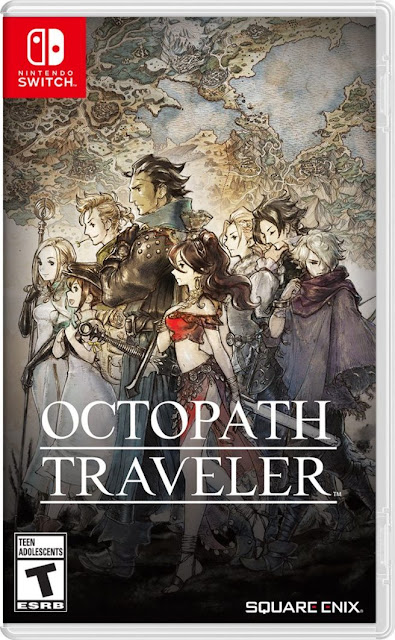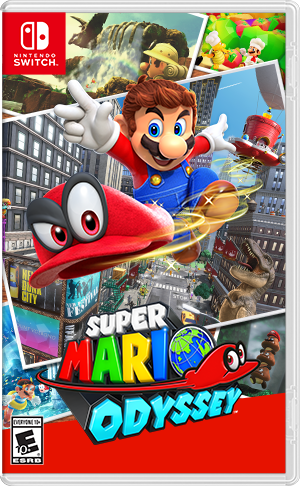Octopath Traveler
 |
| Released on July 13, 2018 for the Nintendo Switch by Square Enix, Octopath Traveler features old-school, 16-bit JRPG action in a modernized package. |
I have to think hard to remember the last time I played through a new JRPG. Skies of Arcadia for the Dreamcast in 2001? It's been a long time. The Nintendo Gamecube wasn't exactly a hotbed for the genre, and I missed almost the entire generation after that. Coming back into modern gaming, the genre has become frightening and intimidating. 300 hours to beat a game? No thanks! My favorite game of all time, coincidentally, a mid-90's SNES JRPG, only takes 25 hours to complete. With all of my retro-gaming interests (I've played plenty of classic JRPG's during this modern JRPG hiatus), let alone my desire to play through as many new Nintendo Switch releases as possible, I don't exactly have 100+ hours to give to any games that don't start with the words "The Legend of Zelda." When Square Enix announced Octopath Traveler, a Switch exclusive, as its new mantle-bearer for the spirit of 16-bit JRPG's, my interest was peaked. I love 16-bit JRPG's. However, Octopath's reported content overwhelmed me. Eight playable main-characters, each with their own in-depth story to play through? When would I find the time for this?
I waffled back-and-forth about purchasing the game during the week leading up to its release.
Thankfully, someone else made the call for me. A good friend of mine surprised me on release day with the special Wayfarer's Edition of the game (which basically features a bunch of extra physical goodies, like a soundtrack and pop-up book). How fortuitous that I had just completed Doom and was ready for my next game. Octopath it was. JRPG time.
People argue about the definition of JRPG, or Japanese Role-Playing Game, and some purists (nerds!) will even argue that the designation should only go to table-top games. The generally accepted meaning is that a JRPG is a Japanese-developed video-game where the fighting is turn-based, and the story is involving.
People argue about the definition of JRPG, or Japanese Role-Playing Game, and some purists (nerds!) will even argue that the designation should only go to table-top games. The generally accepted meaning is that a JRPG is a Japanese-developed video-game where the fighting is turn-based, and the story is involving.
Octopath Traveler certainly fits that bill. You might as well give up, spellcheck. I get that "Octopath" isn't a word, but you're wasting your efforts underlining it. Anyway, the game begins with a character selection screen. There are four males: a burly warrior, a thief, a scholar, and an apothecary. There are also four females: a mysterious dancer, a merchant, a cleric, and a hunter. I only gave adjectives to two of those, because those two are my favorites. You get to pick any one of the eight to start, each from a unique region in the medieval land of Osterra. All of the eight characters have a unique story, composed of four separate chapters. Rather ingeniously, you, as your chosen character, can meet any of the other seven characters in their hometowns, and have up to three of them tag along as you journey through Osterra. You can then choose to experience each of their four chapters as well, and complete them concurrently with your main character's. Once you find them all, you can even switch back and forth between all eight, in one of Osterra's many taverns, meaning you can technically play through all eight stories concurrently (though you can only have four party members at a time). However, playing through with all eight will take an awfully long time, so I picked the four that seemed most interesting to me, and stuck with them. For the interest of this review, I played through Octopath Traveler with Olberic, the Warrior (I am always going to pick this type of character first), Primrose, the Dancer, Therion, the Thief, and H'aanit, the Hunter. Yes, the four most badass characters. I left the scholar, cleric, apothecary, and merchant at home. Sorry, nerds. I'll save that stuff for real life.
The biggest point of contention in this game seems to be that the eight characters' stories are not interconnected. As someone who audibly booed when Chewbacca showed up in Revenge of the Sith(and I LOVE Chewbacca!), I don't need everything to be coincidentally connected. Osterra is a huge world, and there is no reason for these eight characters to have already known each other, or be intertwined in some way. The point that they are tagging along on each others' stories out of a pure sense of empathy and adventure, is quite effective to me. I do wish that the developers had found a way to reflect the characters companionship more in each individual character's story (none of the villains ever ask, "So, who are your three friends?"), but the characters do have unique moments of dialogue interaction which can at times be quite moving.
 |
| Aw, tough guy talk |
 |
| Wow, that's EXACTLY what I look like in real life. Even our stats are similar! |
 |
| You might be 30-feet tall, but my crew ain't impressed, yo |
Also, yes, if you haven't figured it out yet, my favorite game is Chrono Trigger. In that game, the player can actually see his or her enemies as they're walking around in the overworld, and they can decide on their own when they're ready to fight them. This adds an extra level of control and comfort, while not taking away any of the game's difficulty. Also, I wish Octopath Traveler wouldn't require so many extra fights to be undertaken, in order to level up enough to be able to beat its over-sized bosses and progress (aka grinding).
 |
| (SIGH)...Time to fight another pair of giant birds |
Also excellent: the game developers' rather brilliant choice to showcase Octopath's systems with a combination of retro and modern graphics, where backgrounds are a lifelike blur, and foregrounds are classically pixellated in a 16-bit style. The overall effect isn't given justice in screenshots. In motion, with snow glittering, or water flowing, it's a thing of beauty. The character design is excellent, with each standing out from the other, in beautifully hand-drawn style in some of the menus, as well as in pixel form. To nitpick, when characters pick up a secondary job, their clothing is changed during fights and in the equipment menus, but stays the same on the regular overworld screen. Again, this tiny attention to detail would have made for an even more immersive experience.
 |
| On reflection, only the truly great can be nitpicked |
I may be biased by a nostalgia for this sort of game, but I love Octopath Traveler. I've essentially waited 17 years for it. I can nitpick about the things that hold it back from perfection, but those things have done little to temper my enjoyment. I may have spent 60 hours finishing my four characters' stories, but the other four are calling, and I hear there's a bonus dungeon and better ending unlocked whenever their stories and certain side-quests (of which the game has legion) are all completed. I might be moving on to the next game (with Switch's breakneck release schedule, I'll never get to experience every game I want to play), but Osterra will forever live in my heart during the finite time I am alive.
SCORE: 9.5/10





Comments
Post a Comment